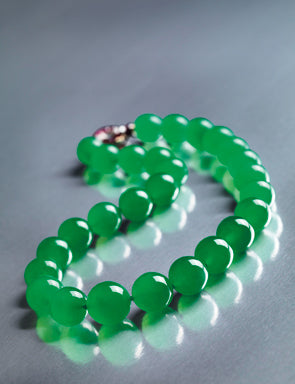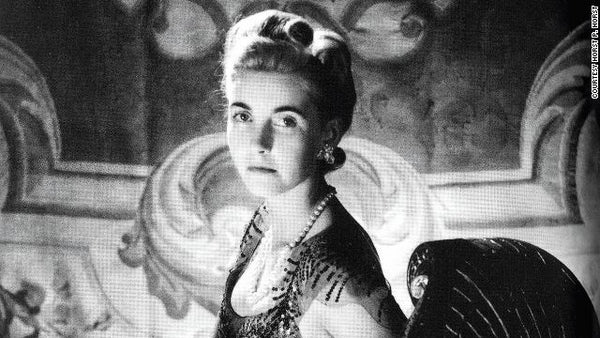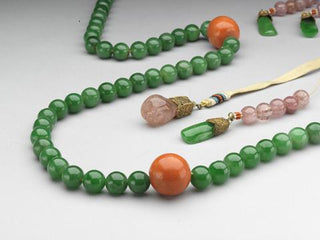 Image: Sotheby's
Image: Sotheby's
An Exceptional Jadeite Bead Necklace of Extreme Importance Formerly in the Collection of Barbara Hutton.
HONG KONG.- Sotheby’s Hong Kong presents The Hutton-Mdivani Necklace, the Greatest Jadeite Bead Necklace of Historical Importance. Expected to fetch in excess of $12.8 million at its Magnificent Jewels and Jadeite Spring Sale to take place on 7 April at the Hong Kong Convention and Exhibition Centre.
The Hutton-Mdivani Necklace has the most illustrious provenance spanning members of Western nobility and Imperial China since the turn of last century, and is widely recognised as the most important piece of jadeite jewellery known to the world.
This jadeite bead necklace, with an innovative clasp by Cartier, comprises 27 gigantic jadeite beads of magnificent green colour, excellent translucency, extremely fine texture and majestic proportions, with diameters ranging from 19.20 mm to 15.40 mm.
A fine complement to the prominence of its past owners, this jadeite bead necklace offers a unique collecting opportunity for jewellery and jadeite connoisseurs. QUEK Chin Yeow, Deputy Chairman and Head of Jewellery Department, Sotheby’s Asia, said, “We are most honoured to be entrusted to offer in our upcoming Magnificent Jewels and Jadeite sale The Hutton-Mdivani Necklace, the greatest jadeite bead necklace in the world.
Of the finest quality and striking proportions, this jadeite bead necklace with a storied past is an epitome of the mysterious and captivating beauty of jadeite, the most revered oriental gemstone, and evokes the glamour of distinguished style icons of both China and the West at the turn of the last century. It stands as the most important piece of jadeite jewellery known to the world and is set to engage keen competition from jewellery cognoscenti.
Barbara Hutton (1912 – 1979) – A Fabled Heiress and Iconic Collector Socialite and heiress Barbara Woolworth Hutton was among the few in the West known for her love for jadeite. Heiress to the retail tycoon Frank Winfield Woolworth, Hutton was one of the wealthiest women in the world when she turned 21, and known for her distinguished taste, lavish lifestyle as well as elegance and beauty.
 Getty Image
Getty Image
American socialite Barbara Hutton was one of the wealthiest heiresses of her time. For her wedding, her father gifted her a precious pearl necklace that once belonged to Mary Antoinette, which she is wearing in this photo from 1939.
A great patron of the renowned jewellery houses, her collection encompassed unique commissioned pieces by the most celebrated jewellers, as well as important royal and noble jewels, among them a pearl necklace formerly belonging to Marie Antoinette, Queen of France.
The World’s Greatest Jadeite Bead Necklace of Supreme Historical Importance The Cartier archive records the jadeite beads being in their possession in 1933 when an innovative clasp was designed especially for the Hutton family. The necklace was then presented as a wedding gift in the same year to Barbara Hutton from her father on the occasion of her marriage to Prince Mdivani.
 Getty Image
Getty Image
Prince Alexis Mdivani of Georgia and Barbara Hutton on their wedding day in 1933.
Photo by Bettman/Corbis
 Image: Sotheby's
Image: Sotheby's
Left: The Hutton-Mdivani jadeite bead necklace and matching ring by Cartier
Right: Barbara Hutton with her first husband, Prince Alexis Mdivani, photographed in 1933 at the Metropolitan Opera House in New York. She is wearing her jadeite necklace and the ruby and diamond bracelet of French manufacture illustrated over the photo.
It was first worn publically by Barbara Hutton at her 21st birthday party, and remained in the Mdivani family for over five decades until it was first sold at auction in 1988 for $2 million and made news headlines as the most expensive piece of jadeite jewellery in the world. Six years later in 1994 it was offered at auction again in Hong Kong, this time doubling its previous price to achieve $4.2 million and once again bringing the price of jadeite jewellery to a new level.
Widely known as the most important piece of jadeite jewellery to date, this necklace comprises 27 highly translucent beads of perfectly matched colour, extremely fine texture and extraordinary majestic proportions ranging from 19.20 to 15.40 mm in diameter, as well as a patina and polish consistent with the fine craftsmanship from the late Qing period.
The proportions alone render them highly unusual and impressive, as top-quality jadeite boulders normally yield beads of no more than 5 to 10 mm in diameter due to their extreme scarcity. To fashion a strand of matching jadeite beads, all the beads must be carved from the same boulder and as many as thrice the desired number of beads are often needed from which to select the most suitable ones.With the immense wastage involved, jadeite bead necklaces rank among the most valuable and sought-after forms of jadeite jewellery.
The Hutton-Mdivani Necklace is also remarkable for its design. Jade was incorporated into Western jewellery design in the early 20th century. As Cartier embraced this unique oriental gemstone, carved jade became a notable element in the brand’s signature Art Deco designs and a novel expression of luxury.
The jadeite beads on the necklace were set by Cartier to a ruby and diamond clasp of clean and geometrical design. The red colour of rubies, whilst auspicious in Chinese culture, is also a fine example of the colour palette of the Art Deco period against the luminous green colour of the beads. Qing Jadeite Beads Reputedly From The Imperial Court Classic and elegant, the jadeite bead necklace is among the most popular forms of jadeite jewellery and favoured by the likes of Empress Dowager Cixi of China, Madame Chiang Kai-Shek and Madame Wellington Koo, wife of the famous Chinese diplomat V.K. Wellington Koo.
 Image: Sotheby's
Image: Sotheby's
The Hutton-Mdivani Necklace featuring 27 Qing jadeite beads with a beautiful Art Deco ruby and diamond clasp created by Cartier in 1933.
As a result of political instability in the late 19th century, Imperial treasures were removed from the palace and many of them redesigned into various forms of jewellery. Like many lost treasures, the precise origin of the jadeite beads on this necklace is unknown. Nonetheless, since the beads were of supreme quality and had already found their way to Europe and been customised into a piece of haute joaillerie by Cartier by the early 1930s, they can be dated at least to the late 19th or early 20th century.
The prominence of the original owner of the beads is sufficiently reflected by their supreme quality. Since its introduction as a tribute to the Qing Imperial court in the 18th century, jadeite of various forms was exclusively worn by the ruling class. Imperial court necklaces in particular were worn only by Qing emperors and senior officials.
Considering the impressive size and quality, it is likely the beads on the Hutton-Mdivani Necklace would have been presented to the Imperial court. An Imperial jadeite bead necklace acquired in the early 20th century by Oei Tiong Ham, a successful Chinese businessman in Indonesia, from Beijing’s leading jadeite dealer, Tieh Bao Ting, was sold at Sotheby’s New York in 2010.
While the 30 jadeite beads on the Oei Tiong Ham necklace - originally from a Qing Imperial court necklace - measure 13.40 to 13.30 mm in diameter, the beads on the Hutton-Mdivani Necklace currently offered are far superior in colour, texture, translucency and size, which indicates an equally, if not more distinguished original ownership.
 Image: Sotheby's
Image: Sotheby's
Court Necklace with Green Jadeite Beads Qing dynasty (1644-1911)
Green jadeite, coral, tourmaline, gilt copper, and kingfisher feathers Perimeter: 145 cm; diameter of beads: 1.2 cm National Palace Museum Collection
Partial Information and Images Posted from Jewels du Jour, February 21, 2014
More Information: http://artdaily.com/news/68329/Sotheby-s-Hong-Kong-unveils-the-world-s-greatest-jadeite-bead-necklace-of-supreme-historical-importance#.UwebWf1tdz8[/url]
Copyright © artdaily.org Photo: Sotheby's.
